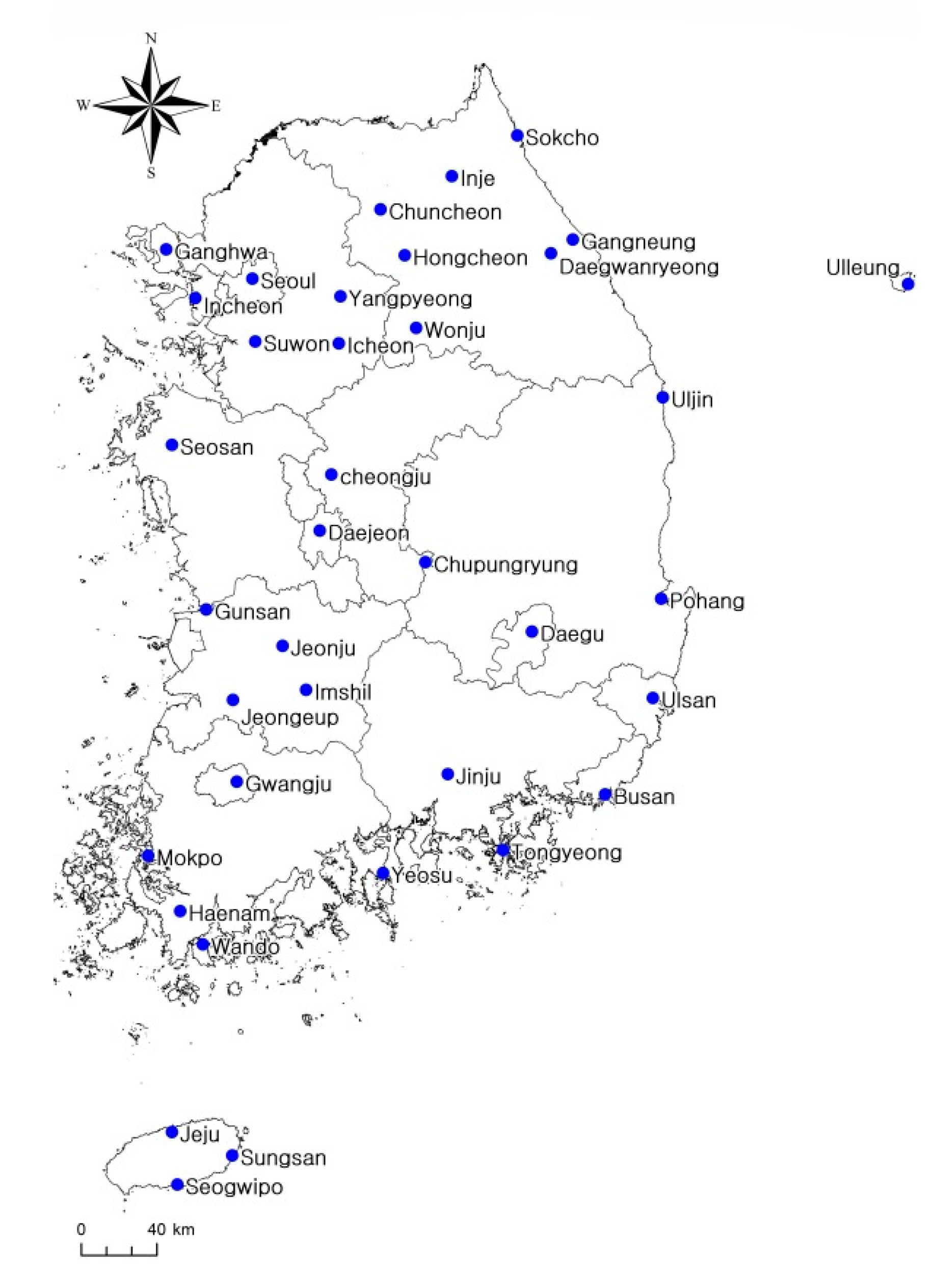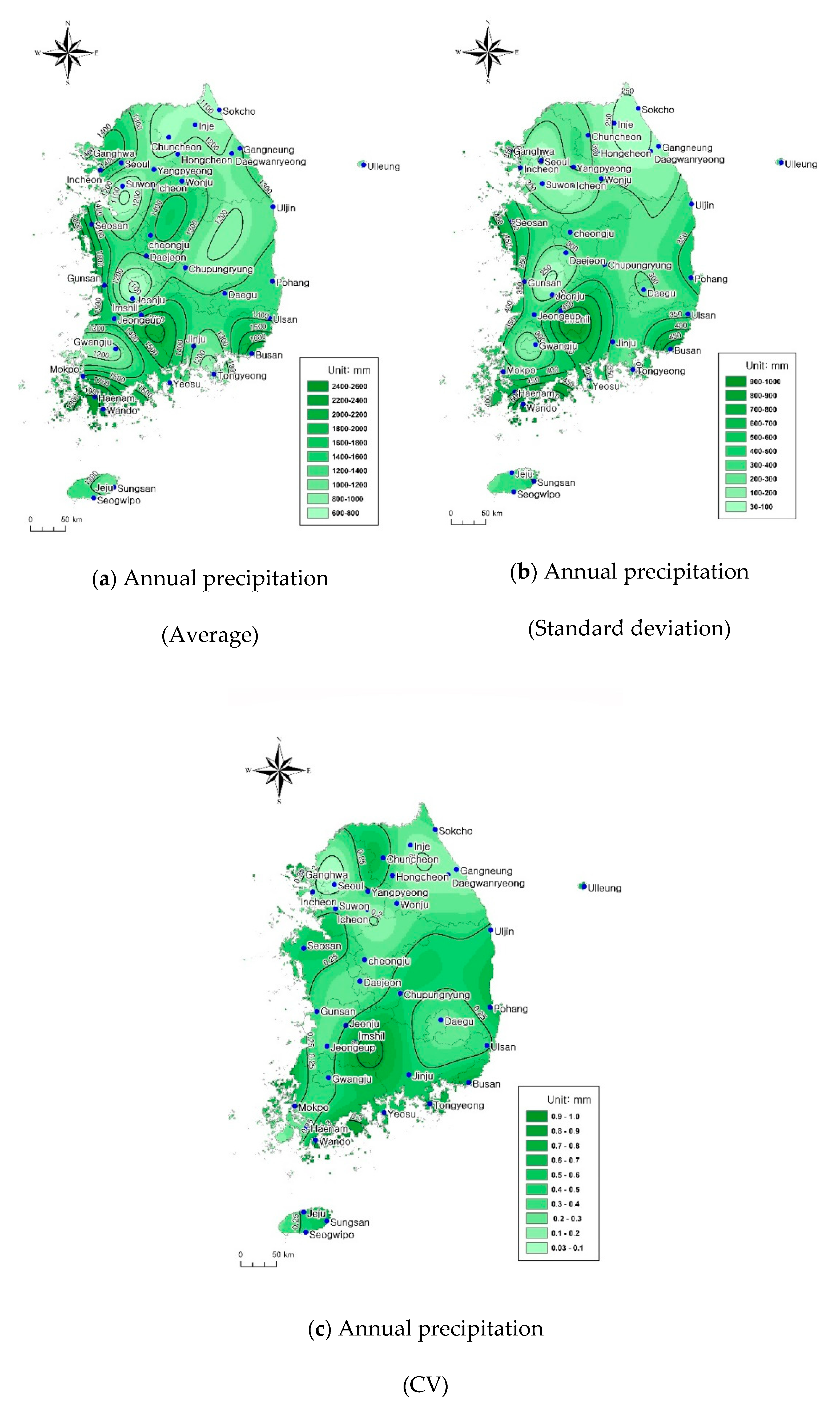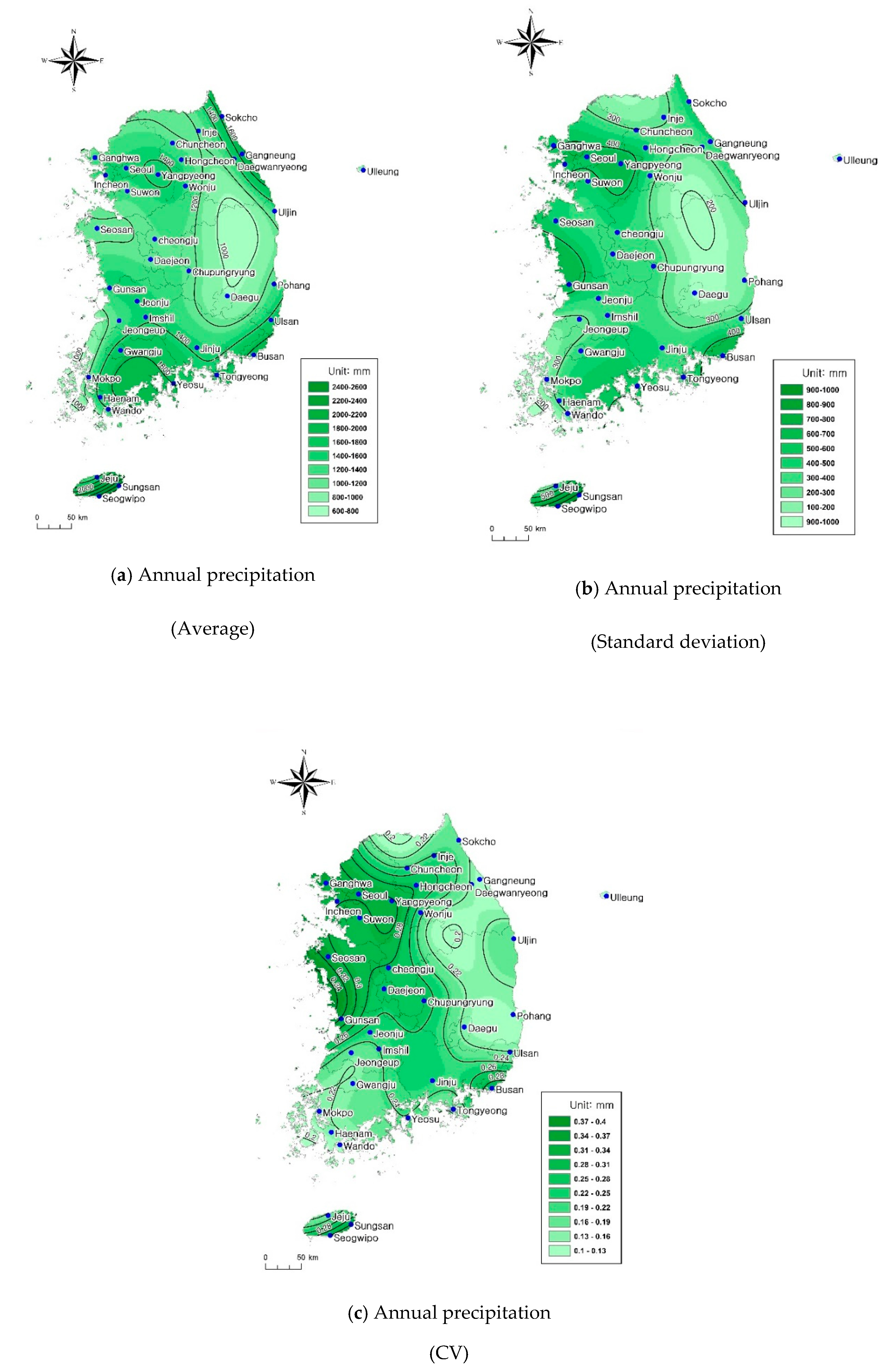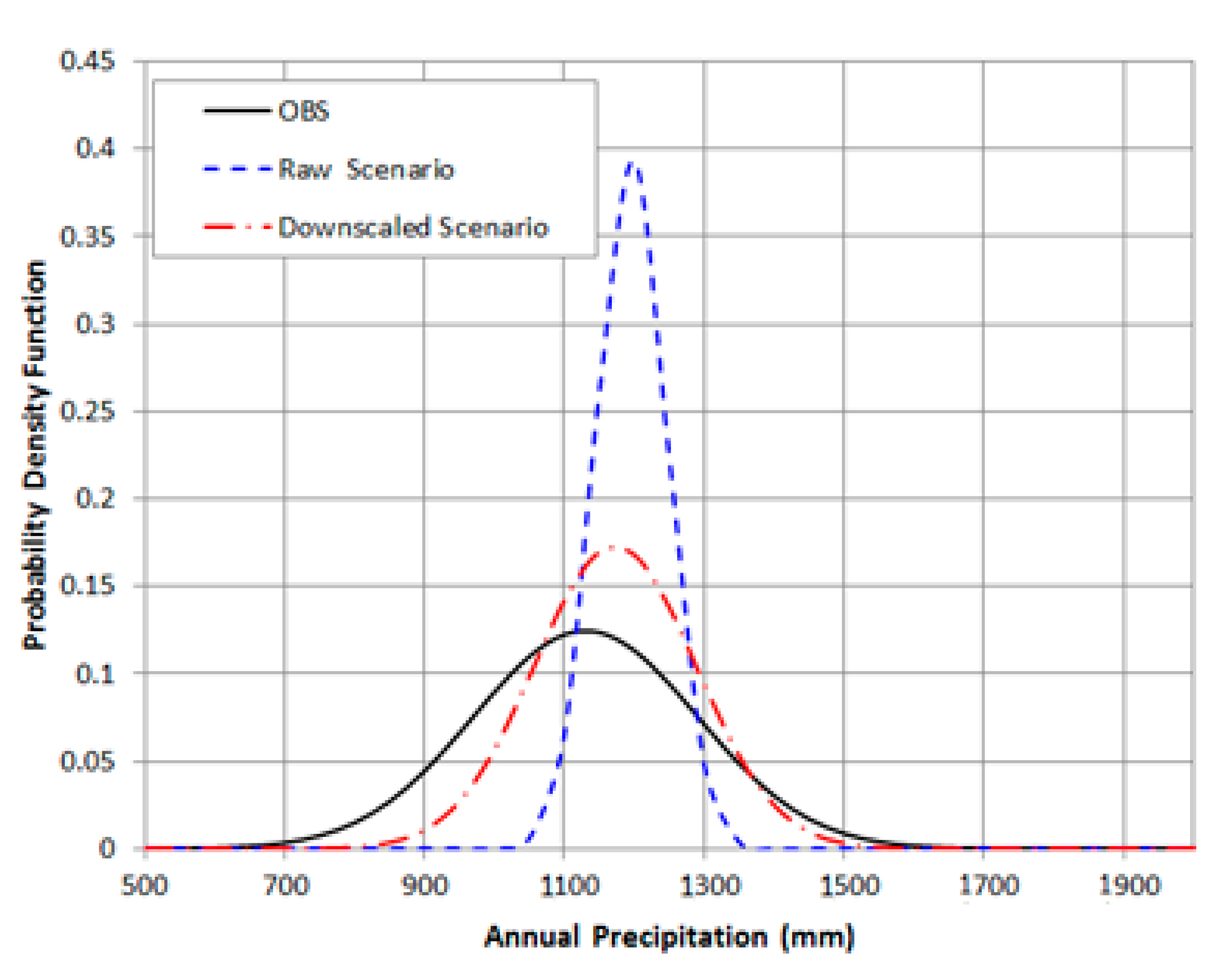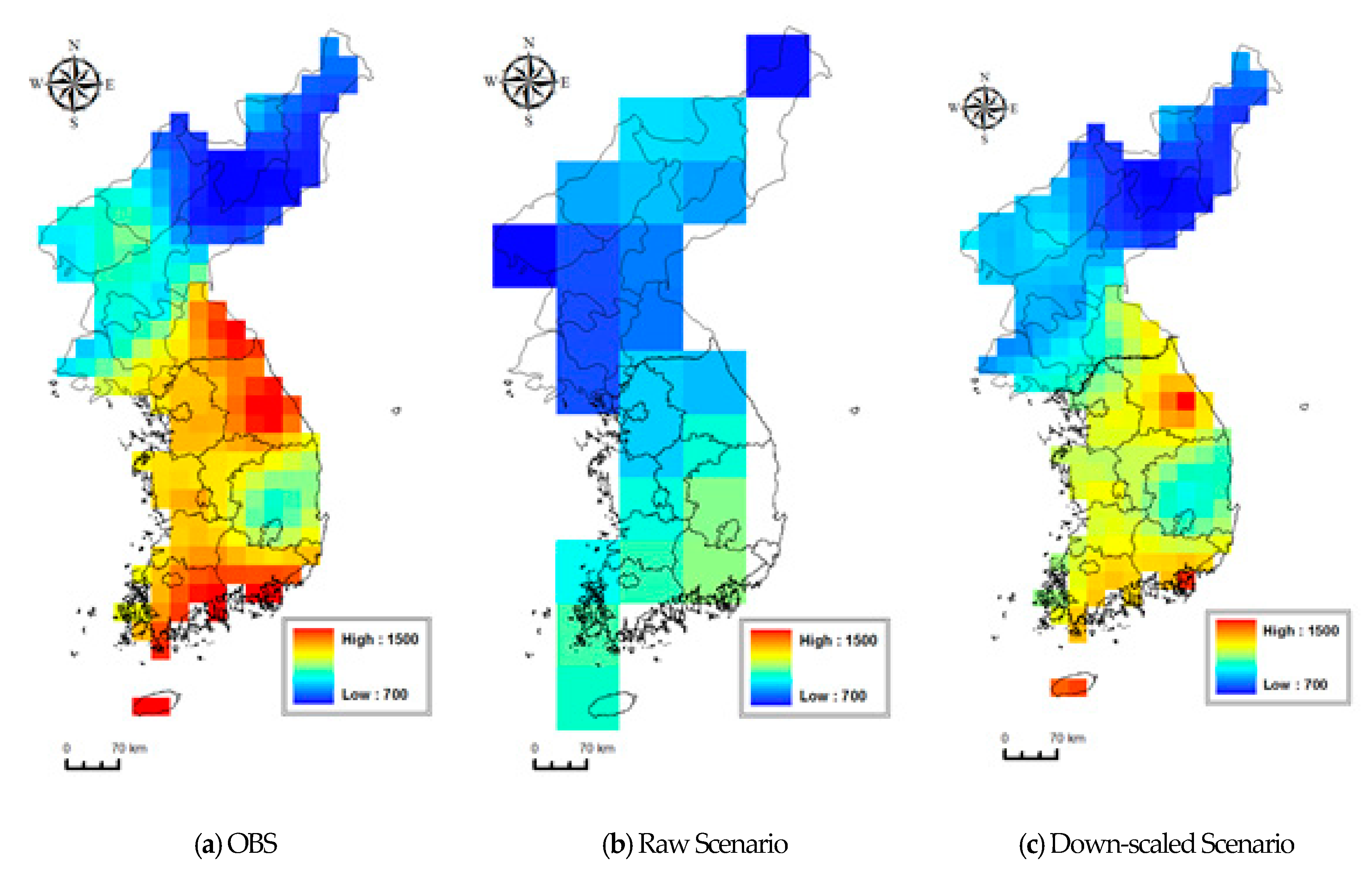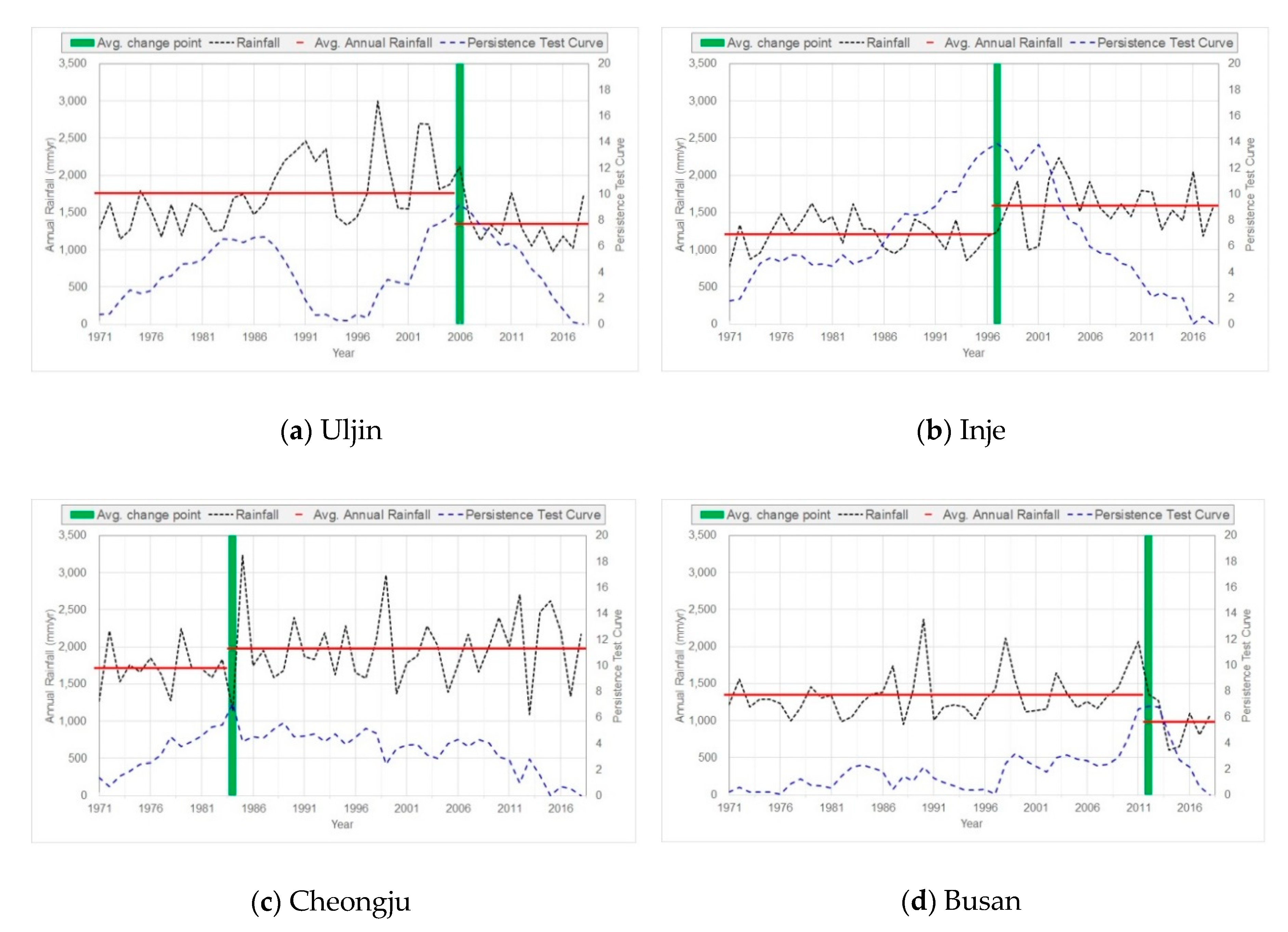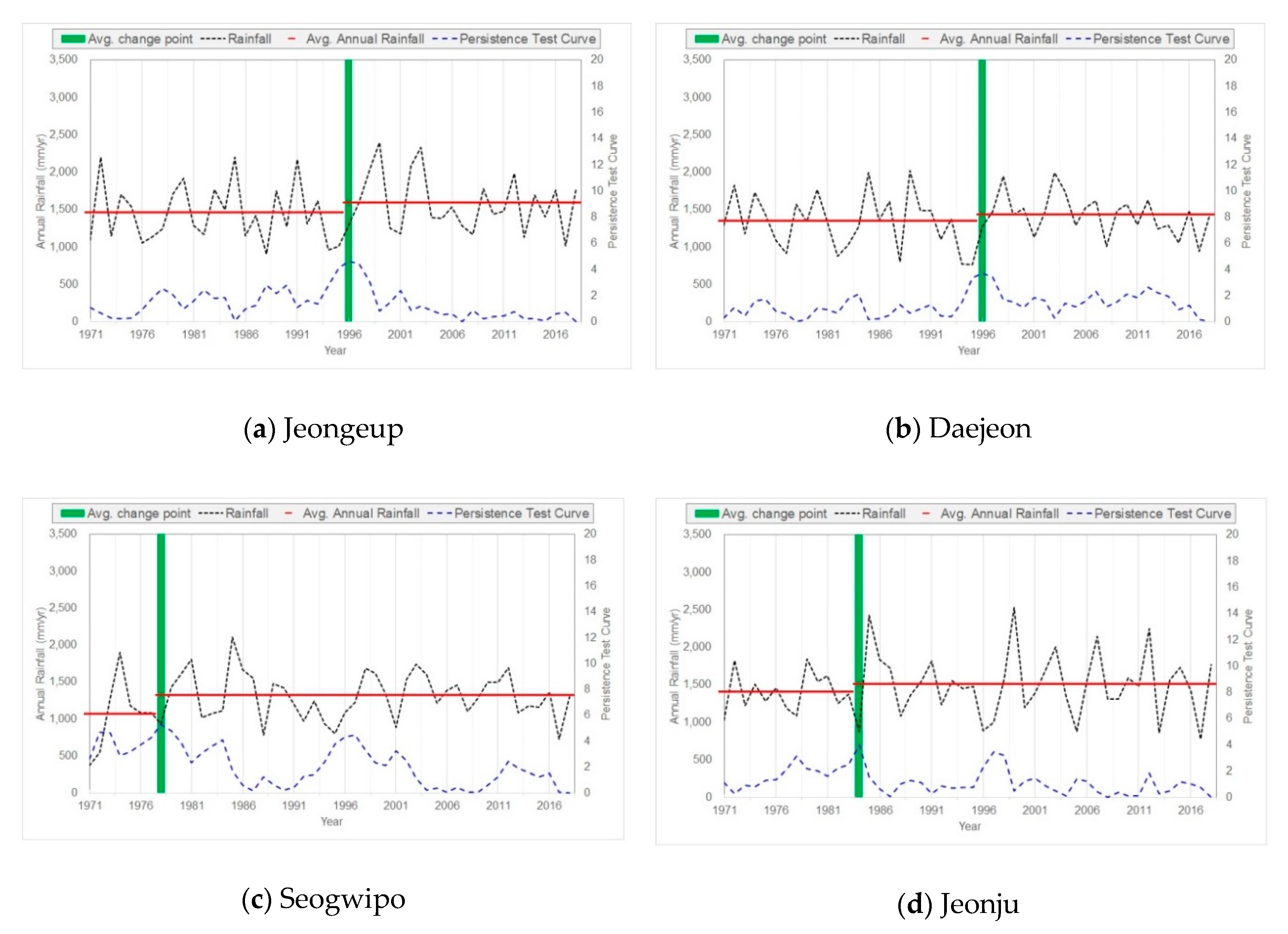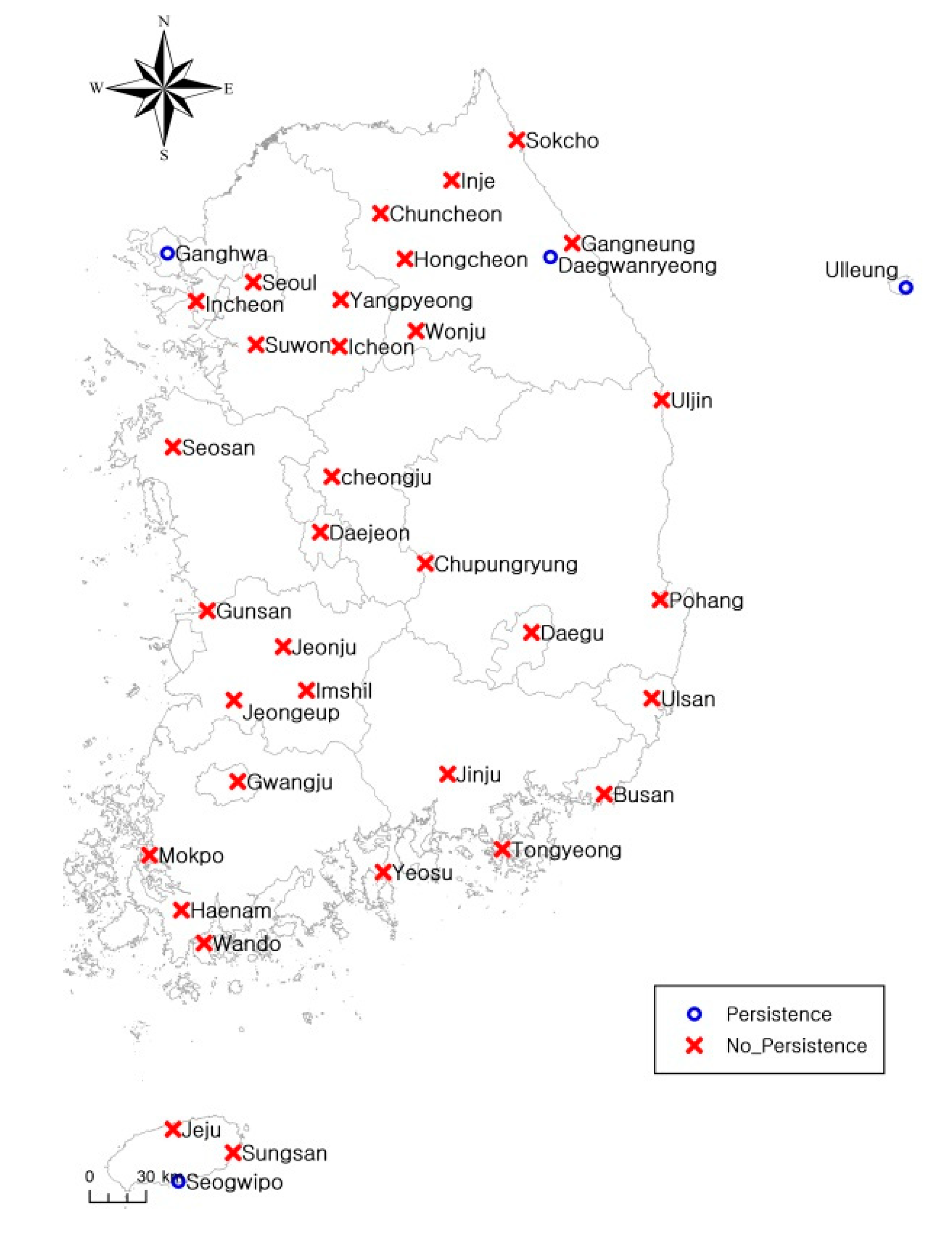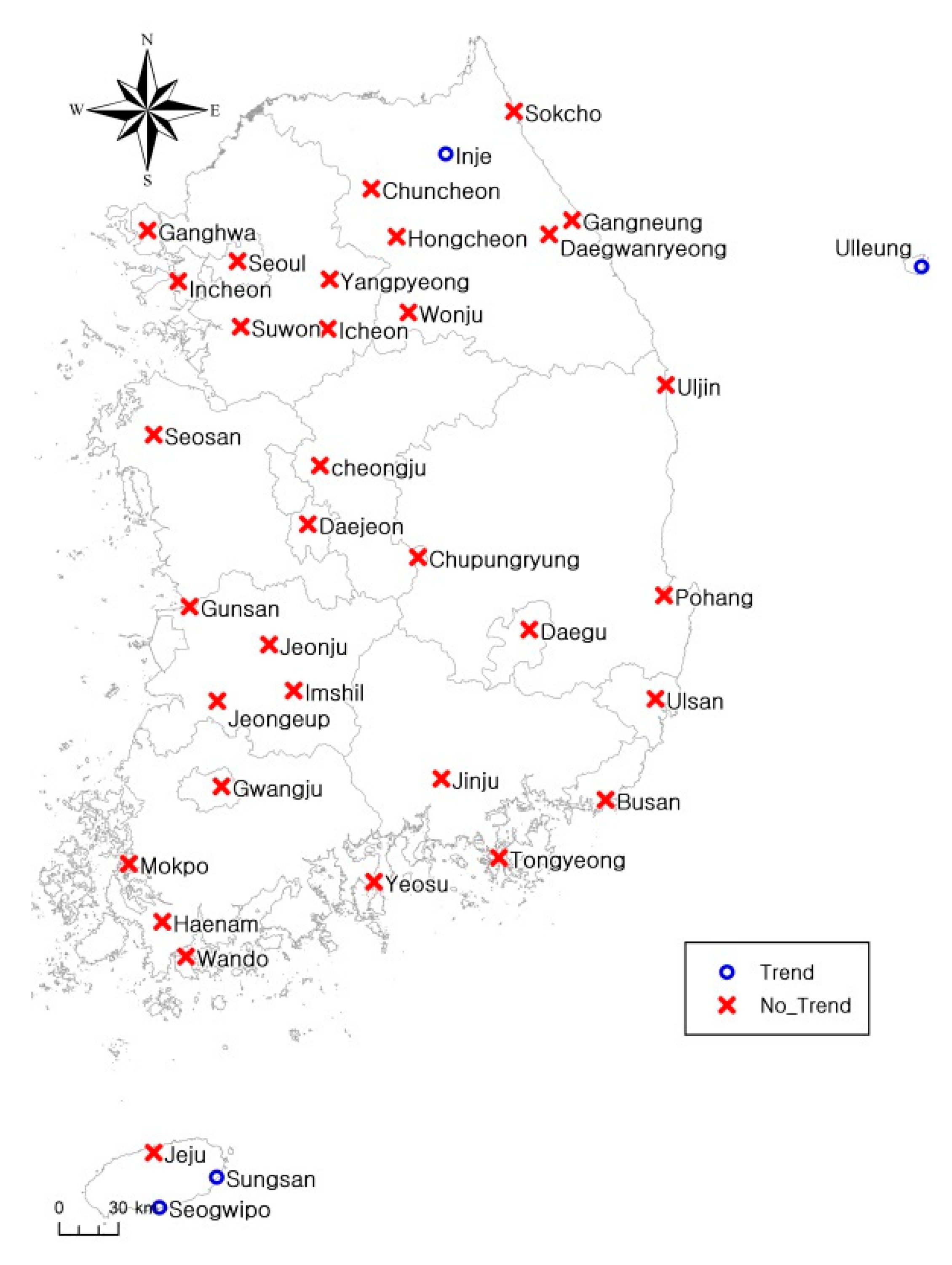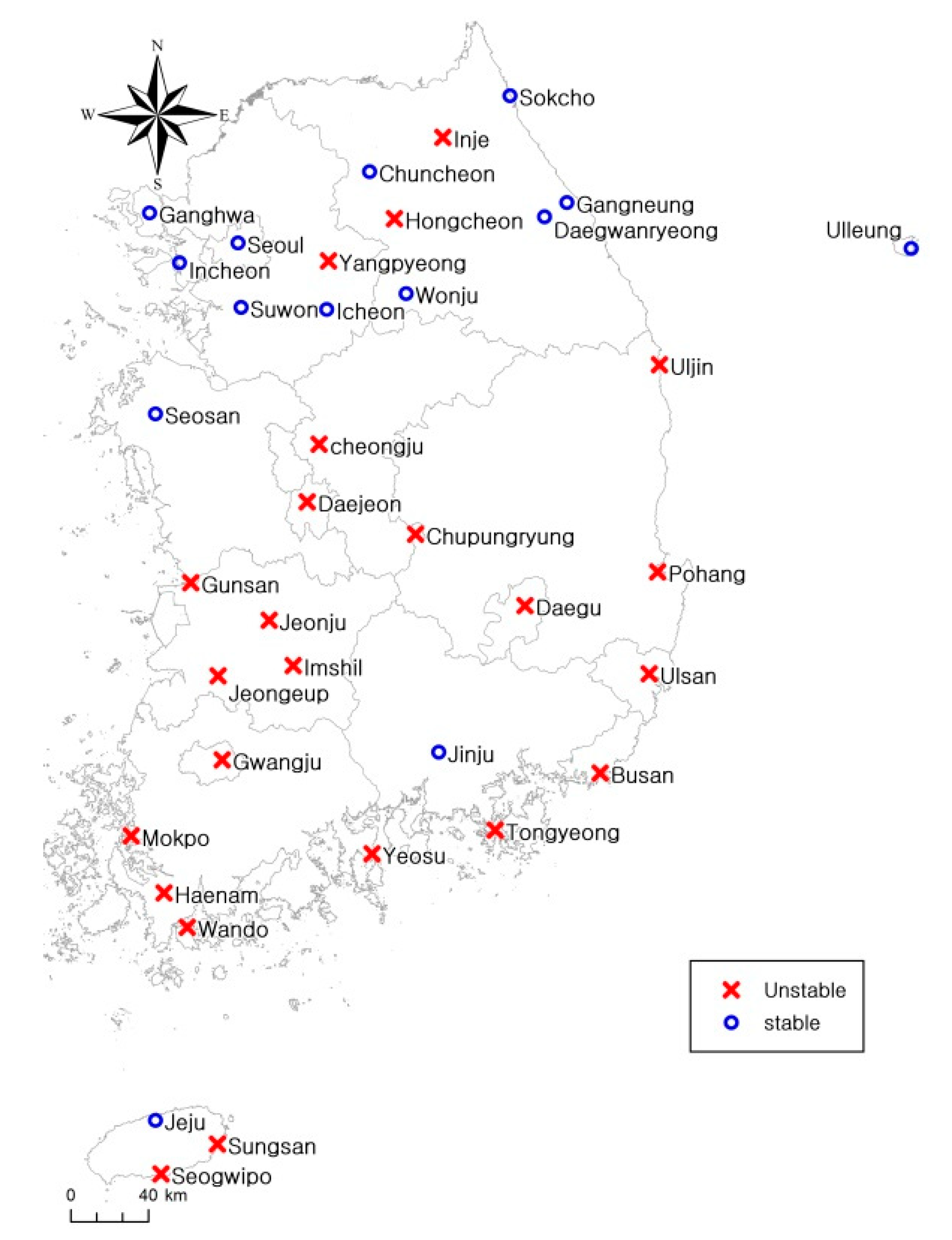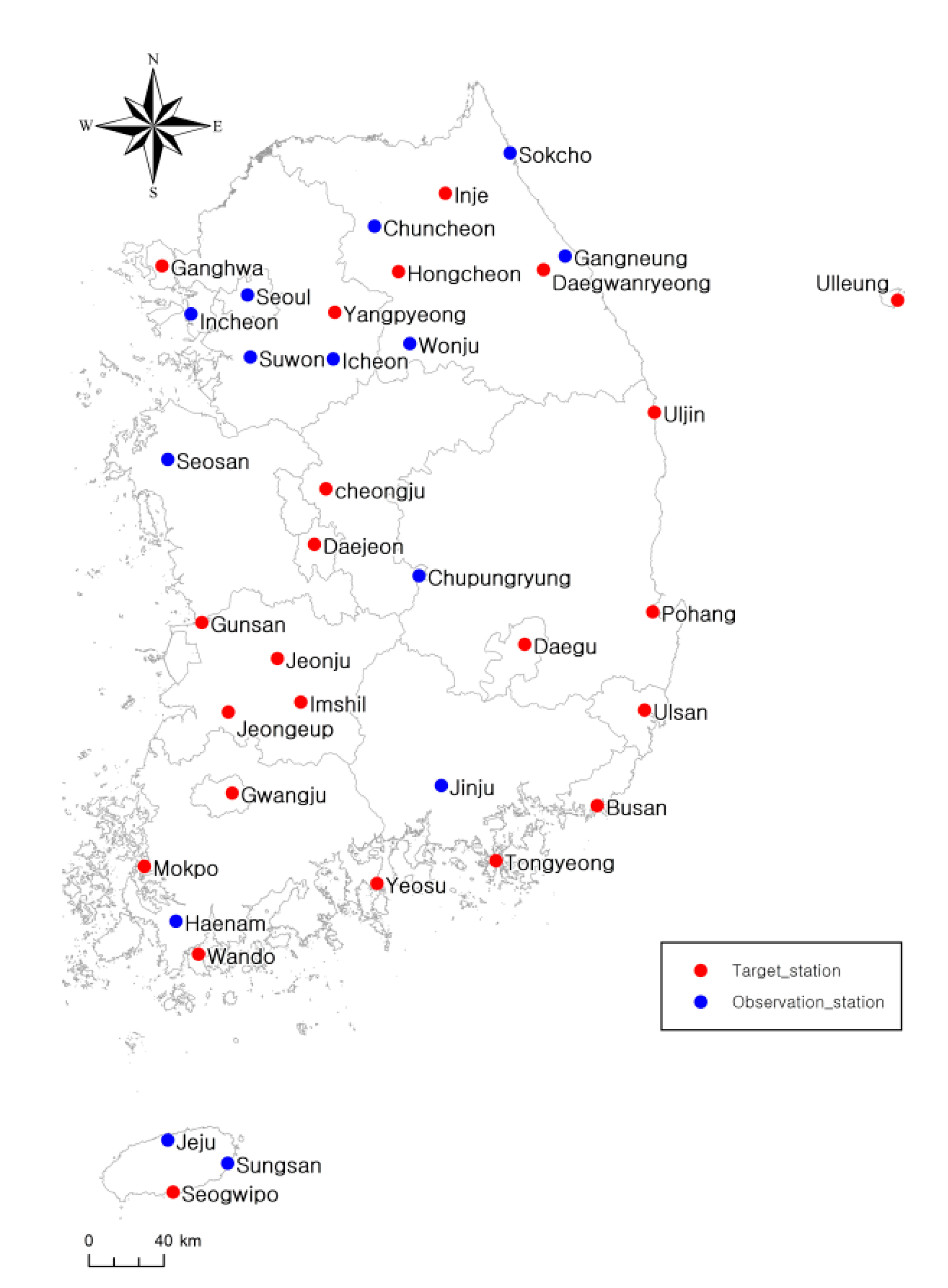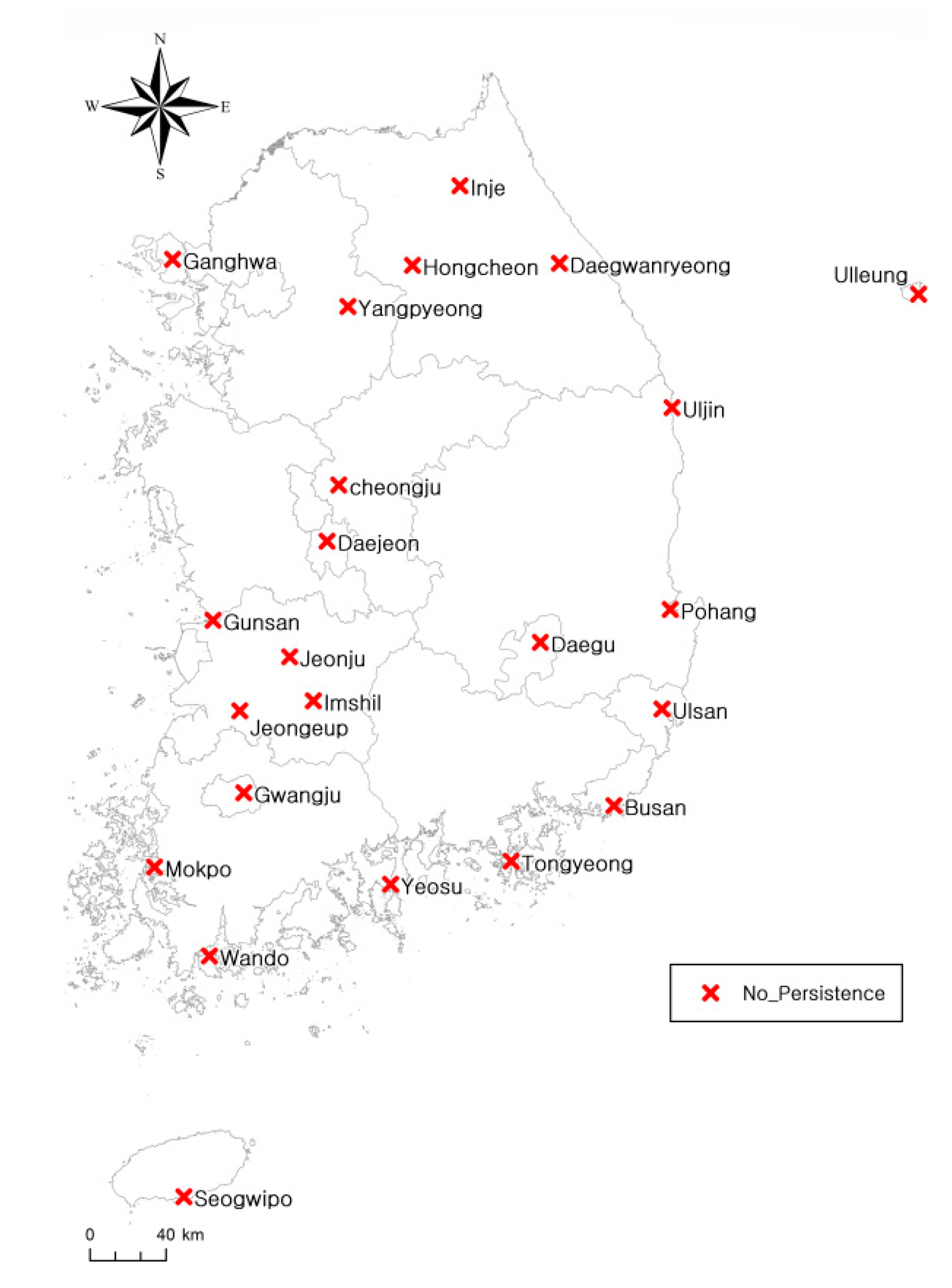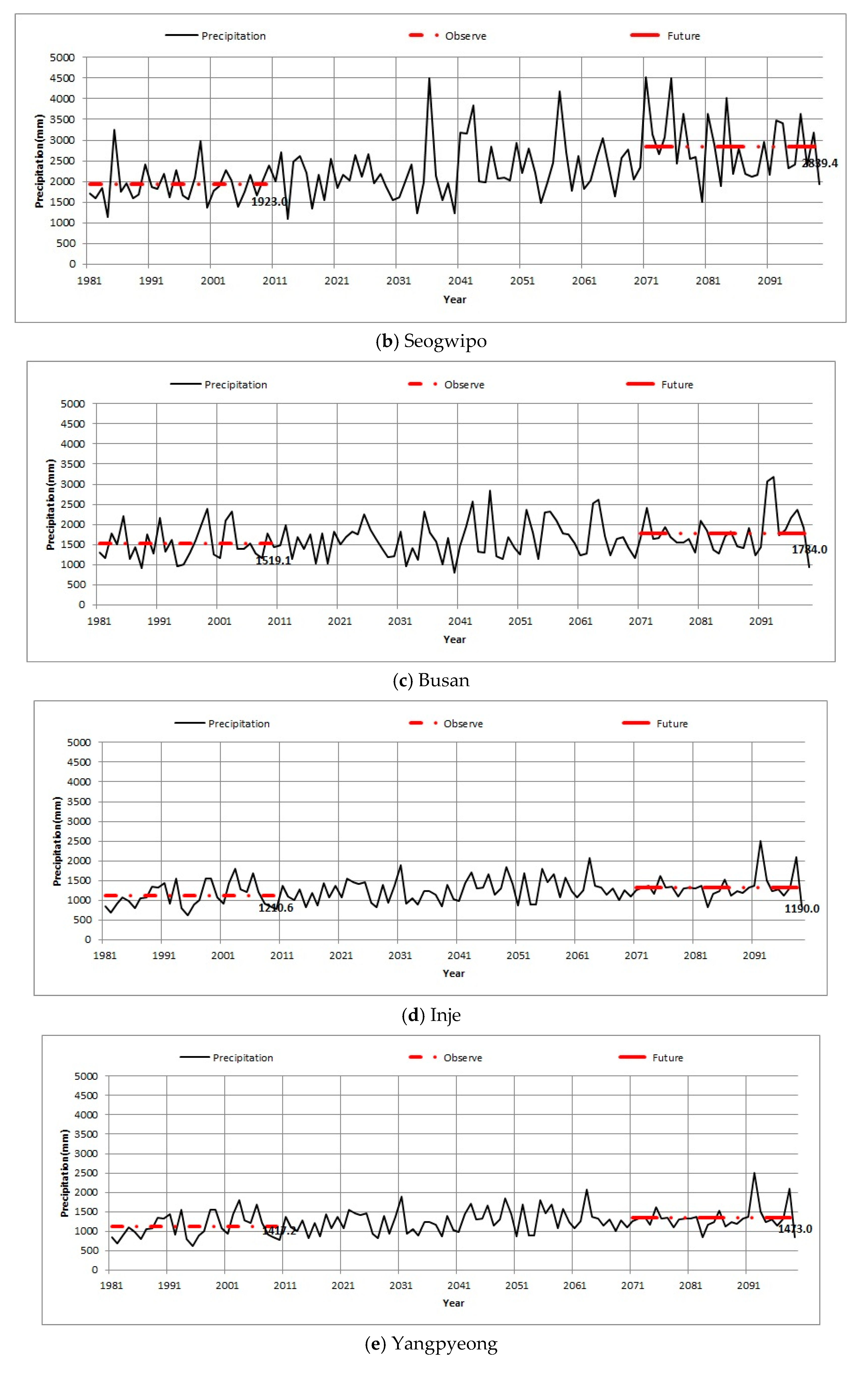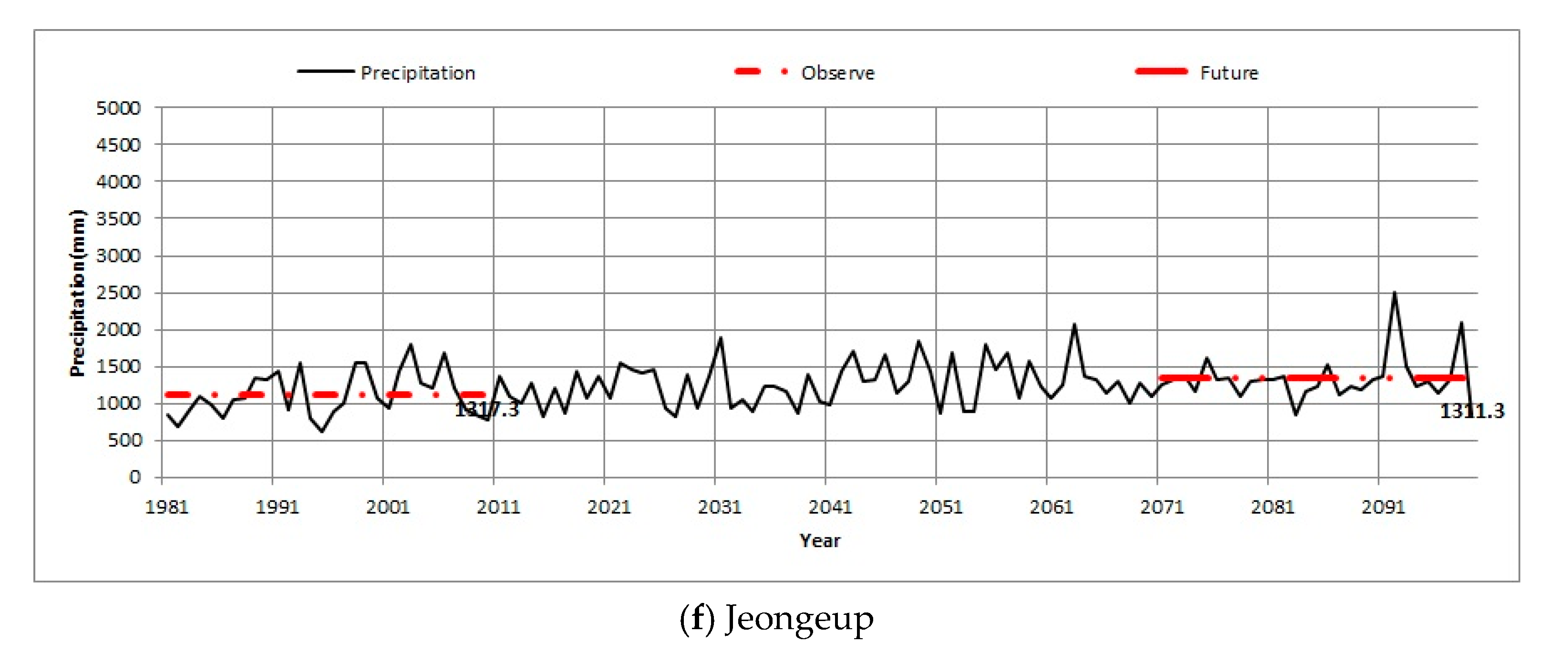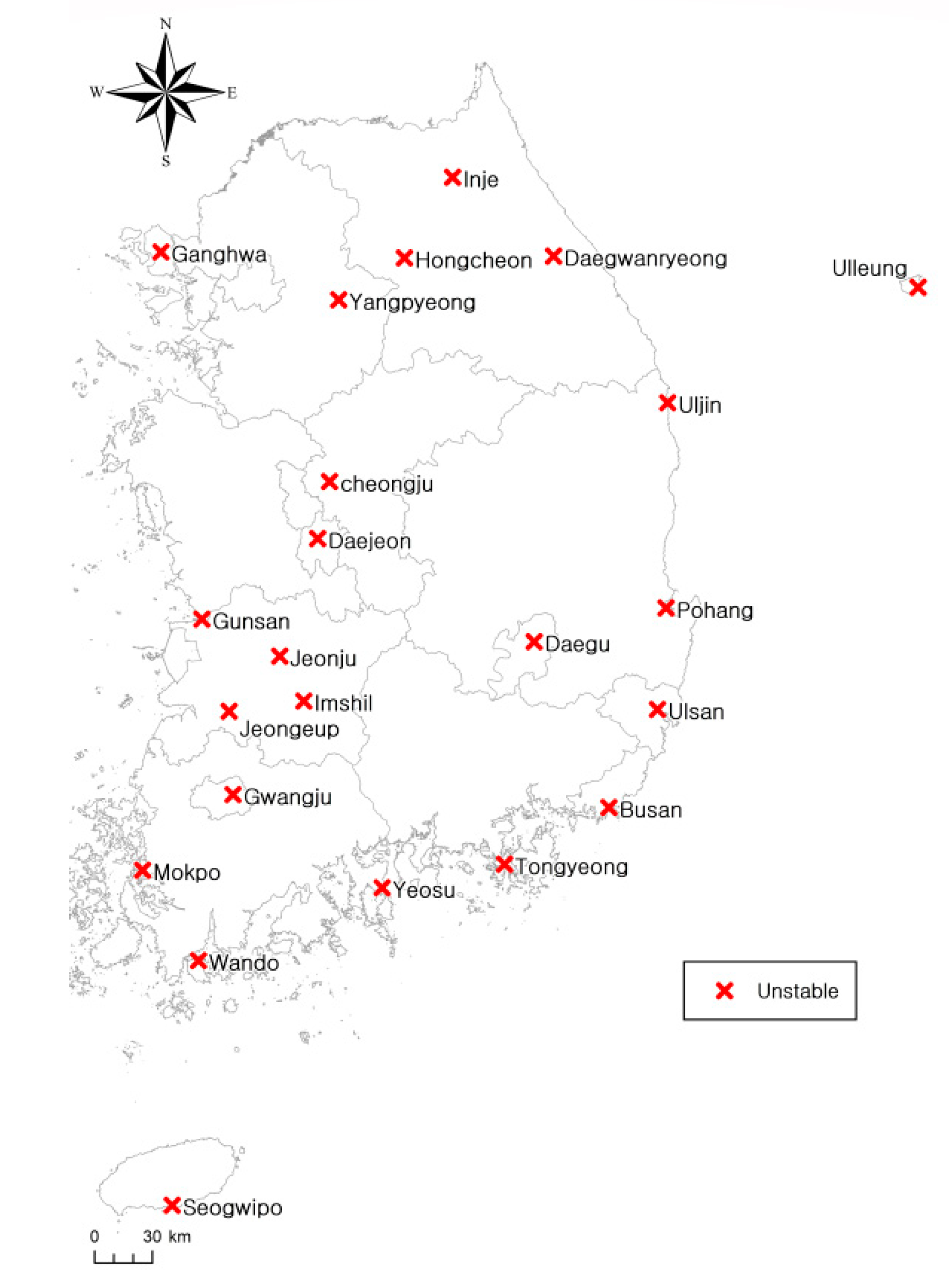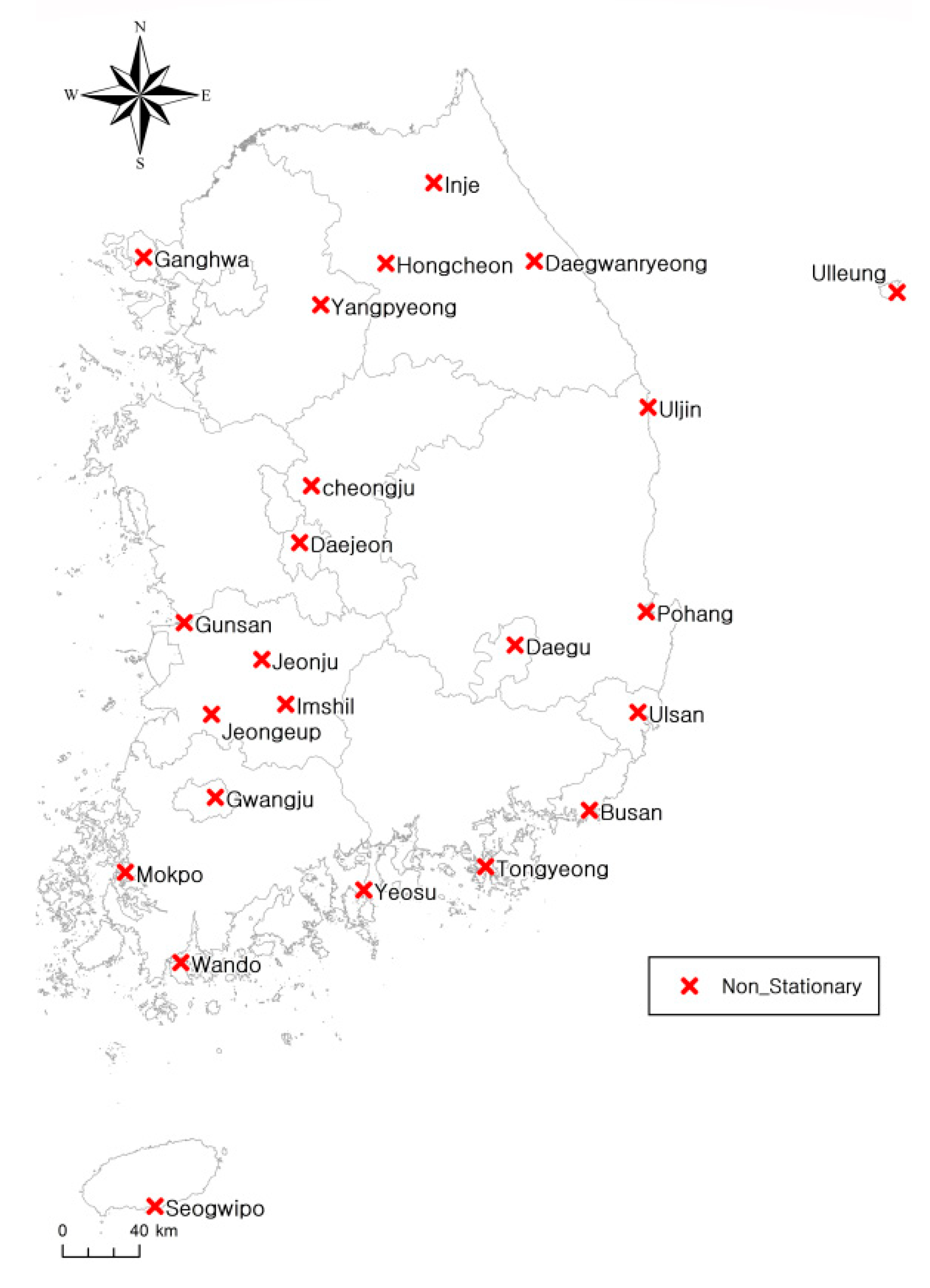Figure 1.
Flow chart of Stationary test.
Figure 1.
Flow chart of Stationary test.
Figure 2.
Stations for the study.
Figure 2.
Stations for the study.
Figure 3.
Average, coefficient of variation (CV), and standard deviation of the annual precipitation (mm). (a) is the average of the annual precipitation, (b) is the standard deviation of the annual precipitation, and (c) is the CV value of the annual precipitation.
Figure 3.
Average, coefficient of variation (CV), and standard deviation of the annual precipitation (mm). (a) is the average of the annual precipitation, (b) is the standard deviation of the annual precipitation, and (c) is the CV value of the annual precipitation.
Figure 4.
Climate Change Scenarios Used in This Study.
Figure 4.
Climate Change Scenarios Used in This Study.
Figure 5.
Average, coefficient of variation (CV), and standard deviation of annual precipitation (mm) using the climate change scenarios. (a) is the average of the annual precipitation, (b) is the standard deviation of the annual precipitation, and (c) is the CV value of the annual precipitation.
Figure 5.
Average, coefficient of variation (CV), and standard deviation of annual precipitation (mm) using the climate change scenarios. (a) is the average of the annual precipitation, (b) is the standard deviation of the annual precipitation, and (c) is the CV value of the annual precipitation.
Figure 6.
Observation and probability density functions of before/after application of the spatial disaggregation with quantile delta mapping (SDQDM) (annual precipitation).
Figure 6.
Observation and probability density functions of before/after application of the spatial disaggregation with quantile delta mapping (SDQDM) (annual precipitation).
Figure 7.
Spatial distribution for observation and before/after down-scaling (annual precipitation). (a), (b), and (c) represent OBS, Raw-Scenario, and Down-scaled Scenario respectively.
Figure 7.
Spatial distribution for observation and before/after down-scaling (annual precipitation). (a), (b), and (c) represent OBS, Raw-Scenario, and Down-scaled Scenario respectively.
Figure 8.
Serial correlation coefficient graphs showing persistence. (a), (b), (c), and (d) each represent graphs of Uljin, Inje, Cheongju, and Busan.
Figure 8.
Serial correlation coefficient graphs showing persistence. (a), (b), (c), and (d) each represent graphs of Uljin, Inje, Cheongju, and Busan.
Figure 9.
Serial correlation coefficient graphs showing no persistence. (a), (b), (c), and (d) each represent graphs of Jeongeup, Daejeon, Seogwipo, and Jeonju.
Figure 9.
Serial correlation coefficient graphs showing no persistence. (a), (b), (c), and (d) each represent graphs of Jeongeup, Daejeon, Seogwipo, and Jeonju.
Figure 10.
Persistence analysis result for each station.
Figure 10.
Persistence analysis result for each station.
Figure 11.
Trend analysis result for each station.
Figure 11.
Trend analysis result for each station.
Figure 12.
Stability test results.
Figure 12.
Stability test results.
Figure 13.
Stationarity analysis result.
Figure 13.
Stationarity analysis result.
Figure 14.
Target stations.
Figure 14.
Target stations.
Figure 15.
Cumulative deviation graphs using climate change scenarios (no persistence). (a), (b), (c), and (d) each represent graphs of Jeongeup, Daejeon, Seogwipo, and Jeonju.
Figure 15.
Cumulative deviation graphs using climate change scenarios (no persistence). (a), (b), (c), and (d) each represent graphs of Jeongeup, Daejeon, Seogwipo, and Jeonju.
Figure 16.
Persistence analysis results using the climate change scenarios.
Figure 16.
Persistence analysis results using the climate change scenarios.
Figure 17.
Trend analysis of observed and future annual precipitation. (a), (b), (c), (d), (e), and (f) each represent graphs of Uljin, Seogwipo, Busan, Inje, Yangpyong, and Jeongeup.
Figure 17.
Trend analysis of observed and future annual precipitation. (a), (b), (c), (d), (e), and (f) each represent graphs of Uljin, Seogwipo, Busan, Inje, Yangpyong, and Jeongeup.
Figure 18.
Trend analysis using climate change scenarios.
Figure 18.
Trend analysis using climate change scenarios.
Figure 19.
Stability test results using the climate change scenarios.
Figure 19.
Stability test results using the climate change scenarios.
Figure 20.
Results of the stationarity analysis using climate change scenarios.
Figure 20.
Results of the stationarity analysis using climate change scenarios.
Table 1.
Thirteen global climate models (GCMs) used for the study.
Table 1.
Thirteen global climate models (GCMs) used for the study.
| No. | GCMs | Resolution
(Degree) | Institution |
|---|
| 1 | CanESM2 | 2.813 × 2.791 | Canadian Centre for Climate Modelling and Analysis (CCCMA) |
| 2 | CESM1-BGC | 1.250 × 0.942 | National Center for Atmospheric Research (NCAR) |
| 3 | CMCC-CM | 0.750 × 0.748 | Centro Euro-Mediterraneo per I Cambiamenti Climatici |
| 4 | CMCC-CMS | 1.875 × 1.865 |
| 5 | CNRM-CM5 | 1.406 × 1.401 | Centre National de Recherches Meteorologiques |
| 6 | GFDL-ESM2G | 2.500 × 2.023 | Geophysical Fluid Dynamics Laboratory |
| 7 | HadGEM2-AO | 1.875 × 1.250 | Met Office Hadley Centre for Climate Science and Services |
| 8 | HadGEM2-ES | 1.875 × 1.250 |
| 9 | INM-CM4 | 2.000 × 1.500 | Institute of Numerical Mathematics |
| 10 | IPSL-CM5A-LR | 3.750 × 1.895 | Institut Pierre-Simon Laplace |
| 11 | IPSL-CM5A-MR | 2.500 × 1.268 |
| 12 | MRI-CGCM3 | 1.125 × 1.122 | Meteorological Research Institute |
| 13 | NorESM1-M | 2.500 × 1.895 | Norwegian Climate Centre |
Table 2.
Serial correlation coefficient analysis for annual precipitation data.
Table 2.
Serial correlation coefficient analysis for annual precipitation data.
| No. | Station | | Decision | No. | Station | | Decision |
|---|
| 90 | Sokcho | 0.03 | NP | 156 | Gwangju | 0.00 | NP |
| 100 | Daegwanryeong | 0.54 | P | 159 | Busan | −0.12 | NP |
| 101 | Chuncheon | 0.30 | NP | 162 | Tongyeong | −0.07 | NP |
| 105 | Gangneung | 0.24 | NP | 165 | Mokpo | −0.03 | NP |
| 108 | Seoul | 0.20 | NP | 168 | Yeosu | −0.06 | NP |
| 112 | Incheon | 0.20 | NP | 170 | Wando | 0.21 | NP |
| 114 | Wonju | 0.14 | NP | 184 | Jeju | −0.15 | NP |
| 115 | Ulleung | 0.35 | P | 188 | Sungsan | 0.18 | NP |
| 119 | Suwon | 0.21 | NP | 189 | Seogwipo | 0.28 | P |
| 129 | Seosan | 0.18 | NP | 192 | Jinju | 0.00 | NP |
| 130 | Uljin | 0.19 | NP | 201 | Ganghwa | 0.27 | P |
| 131 | Cheongju | 0.10 | NP | 202 | Yangpyeong | 0.17 | NP |
| 133 | Daejeon | 0.04 | NP | 203 | Icheon | 0.09 | NP |
| 135 | Chupungnyeong | 0.15 | NP | 211 | Inje | −0.03 | NP |
| 138 | Pohang | −0.03 | NP | 212 | Hongcheon | 0.19 | NP |
| 140 | Gunsan | −0.04 | NP | 244 | Imshil | 0.16 | NP |
| 143 | Daegu | 0.12 | NP | 245 | Jeongeup | 0.26 | NP |
| 146 | Jeonju | 0.05 | NP | 261 | Haenam | 0.26 | NP |
| 152 | Ulsan | −0.16 | NP | | | | |
Table 3.
Analysis of the Spearman rank correlation of annual precipitation data.
Table 3.
Analysis of the Spearman rank correlation of annual precipitation data.
| No. | Station | | Decision | No. | Station | | Decision |
|---|
| 90 | Sokcho | 0.94 | NT | 156 | Gwangju | 0.03 | NT |
| 100 | Daegwanryeong | −0.42 | NT | 159 | Busan | 0.80 | NT |
| 101 | Chuncheon | 1.83 | NT | 162 | Tongyeong | 1.61 | NT |
| 105 | Gangneung | −0.20 | NT | 165 | Mokpo | 0.71 | NT |
| 108 | Seoul | 1.39 | NT | 168 | Yeosu | 1.01 | NT |
| 112 | Incheon | 1.21 | NT | 170 | Wando | 1.74 | NT |
| 114 | Wonju | 0.29 | NT | 184 | Jeju | 0.59 | NT |
| 115 | Ulleung | 3.53 | T | 188 | Sungsan | 3.16 | T |
| 119 | Suwon | 1.43 | NT | 189 | Seogwipo | 2.12 | T |
| 129 | Seosan | 0.17 | NT | 192 | Jinju | 0.46 | NT |
| 130 | Uljin | 0.33 | NT | 201 | Ganghwa | −0.75 | NT |
| 131 | Cheongju | 0.74 | NT | 202 | Yangpyeong | 1.69 | NT |
| 133 | Daejeon | 0.24 | NT | 203 | Icheon | 0.42 | NT |
| 135 | Chupungnyeong | 0.19 | NT | 211 | Inje | 2.04 | T |
| 138 | Pohang | 0.50 | NT | 212 | Hongcheon | 1.09 | NT |
| 140 | Gunsan | 0.56 | NT | 244 | Imshil | 0.81 | NT |
| 143 | Daegu | 1.04 | NT | 245 | Jeongeup | 0.83 | NT |
| 146 | Jeonju | −0.11 | NT | 261 | Haenam | 0.83 | NT |
| 152 | Ulsan | 0.29 | NT | | | | |
Table 4.
Simple T-test and F-test analysis of annual precipitation data.
Table 4.
Simple T-test and F-test analysis of annual precipitation data.
| No. | Station | T-Test | F-Test | Decision | No. | Station | T-Test | F-Test | Decision |
|---|
| | | |
|---|
| 90 | Sokcho | −0.34 | 1.11 | S | 156 | Gwangju | −4.35 | 1.45 | US |
| 100 | Daegwanryeong | 0.03 | 0.52 | S | 159 | Busan | −8.28 | 0.98 | US |
| 101 | Chuncheon | −0.53 | 0.71 | S | 162 | Tongyeong | −12.87 | 0.77 | US |
| 105 | Gangneung | −0.06 | 0.48 | S | 165 | Mokpo | −6.26 | 1.29 | US |
| 108 | Seoul | −0.47 | 0.72 | S | 168 | Yeosu | −4.37 | 1.12 | US |
| 112 | Incheon | −0.42 | 0.88 | S | 170 | Wando | −12.98 | 1.15 | US |
| 114 | Wonju | −0.06 | 0.55 | S | 184 | Jeju | −1.24 | 0.58 | S |
| 115 | Ulleung | −0.11 | 0.47 | S | 188 | Sungsan | −13.73 | 3.35 | US |
| 119 | Suwon | −0.02 | 0.90 | S | 189 | Seogwipo | −6.61 | 0.84 | US |
| 129 | Seosan | 0.00 | 0.47 | S | 192 | Jinju | −1.67 | 1.06 | S |
| 130 | Uljin | −19.46 | 0.56 | US | 201 | Ganghwa | 0.37 | 0.64 | S |
| 131 | Cheongju | −19.76 | 0.58 | US | 202 | Yangpyeong | −5.21 | 0.85 | US |
| 133 | Daejeon | −22.59 | 0.59 | US | 203 | Icheon | −1.34 | 1.42 | S |
| 135 | Chupungnyeong | −19.38 | 0.64 | US | 211 | Inje | −5.90 | 1.19 | US |
| 138 | Pohang | −17.98 | 0.49 | US | 212 | Hongcheon | −2.53 | 0.81 | US |
| 140 | Gunsan | −15.41 | 0.79 | US | 244 | Imshil | −2.47 | 1.84 | US |
| 143 | Daegu | −14.37 | 0.76 | US | 245 | Jeongeup | −2.88 | 1.78 | US |
| 146 | Jeonju | −4.24 | 1.04 | US | 261 | Haenam | −1.02 | 2.18 | US |
| 152 | Ulsan | 3.41 | 0.90 | US | | | | | |
Table 5.
Estimation of the stationarity of annual precipitation data.
Table 5.
Estimation of the stationarity of annual precipitation data.
| No. | Station | | | | Stationarity | No. | Station | | | | Stationarity |
|---|
| 90 | Sokcho | NP | S | NT | O | 156 | Gwangju | NP | US | NT | X |
| 100 | Daegwanryeong | P | S | NT | X | 159 | Busan | NP | US | NT | X |
| 101 | Chuncheon | NP | S | NT | O | 162 | Tongyeong | NP | US | NT | X |
| 105 | Gangneung | NP | S | NT | O | 165 | Mokpo | NP | US | NT | X |
| 108 | Seoul | NP | S | NT | O | 168 | Yeosu | NP | US | NT | X |
| 112 | Incheon | NP | S | NT | O | 170 | Wando | NP | US | NT | X |
| 114 | Wonju | NP | S | NT | O | 184 | Jeju | NP | S | NT | O |
| 115 | Ulleung | P | S | T | X | 188 | Sungsan | NP | US | T | X |
| 119 | Suwon | NP | S | NT | O | 189 | Seogwipo | P | US | T | X |
| 129 | Seosan | NP | S | NT | O | 192 | Jinju | NP | S | NT | O |
| 130 | Uljin | NP | US | NT | X | 201 | Ganghwa | P | S | NT | X |
| 131 | Cheongju | NP | US | NT | X | 202 | Yangpyeong | NP | US | NT | X |
| 133 | Daejeon | NP | US | NT | X | 203 | Icheon | NP | S | NT | O |
| 135 | Chupungnyeong | NP | US | NT | X | 211 | Inje | NP | US | T | X |
| 138 | Pohang | NP | US | NT | X | 212 | Hongcheon | NP | US | NT | X |
| 140 | Gunsan | NP | US | NT | X | 244 | Imshil | NP | US | NT | X |
| 143 | Daegu | NP | US | NT | X | 245 | Jeongeup | NP | US | NT | X |
| 146 | Jeonju | NP | US | NT | X | 261 | Haenam | NP | S | NT | O |
| 152 | Ulsan | NP | US | NT | X | | | | |
Table 6.
Analysis of the coefficient using climate change scenarios.
Table 6.
Analysis of the coefficient using climate change scenarios.
| No. | Station | | Decision | No. | Station | | Decision |
|---|
| 100 | Daegwanryeong | −0.009 | NP | 156 | Busan | 0.194 | NP |
| 115 | Ulleung | 0.108 | NP | 159 | Tongyeong | 0.104 | NP |
| 130 | Uljin | 0.019 | NP | 162 | Mokpo | 0.092 | NP |
| 131 | Cheongju | −0.067 | NP | 165 | Yeosu | 0.149 | NP |
| 133 | Daejeon | −0.045 | NP | 168 | Wando | 0.118 | NP |
| 135 | Pohang | 0.012 | NP | 170 | Seogwipo | 0.095 | NP |
| 138 | Gunsan | 0.058 | NP | 188 | Yangpyeong | −0.064 | NP |
| 140 | Daegu | −0.015 | NP | 189 | Inje | 0.069 | NP |
| 143 | Jeonju | −0.012 | NP | 202 | Hongcheon | −0.001 | NP |
| 146 | Ulsan | 0.093 | NP | 211 | Imshil | 0.052 | NP |
| 152 | Gwangju | 0.04 | NP | 212 | Jeongeup | −0.003 | NP |
Table 7.
Spearman rank correlation analysis of annual precipitation using climate change scenarios.
Table 7.
Spearman rank correlation analysis of annual precipitation using climate change scenarios.
| No. | Station | | Decision | No. | Station | | Decision |
|---|
| 100 | Daegwanryeong | 1.91 | NT | 159 | Tongyeong | 2.91 | T |
| 115 | Ulleung | −0.98 | NT | 162 | Mokpo | 3.04 | T |
| 130 | Uljin | 0.59 | NT | 165 | Yeosu | 3.36 | T |
| 131 | Cheongju | 0.70 | NT | 168 | Wando | 3.17 | T |
| 133 | Daejeon | 1.36 | NT | 170 | Seogwipo | 4.14 | T |
| 135 | Pohang | 1.94 | NT | 188 | Ganghwa | 2.32 | T |
| 138 | Gunsan | 2.49 | T | 189 | Yangpyeong | 2.16 | T |
| 140 | Daegu | 1.18 | NT | 201 | Inje | 0.00 | NT |
| 143 | Jeonju | 1.69 | NT | 202 | Hongcheon | 0.59 | NT |
| 146 | Ulsan | 2.37 | T | 211 | Imshil | 1.93 | NT |
| 152 | Gwangju | 2.51 | T | 212 | Jeongeup | 2.58 | T |
| 156 | Busan | 2.33 | T | | | | |
Table 8.
Simple T-test and F-test analysis of annual precipitation using climate change scenarios.
Table 8.
Simple T-test and F-test analysis of annual precipitation using climate change scenarios.
| No. | Station | T-Test | F-Test | Decision | No. | Station | T-Test | F-Test | Decision |
|---|
| | | |
|---|
| 100 | Daegwanryeong | −11.44 | 1.005 | US | 159 | Tongyeong | −3.41 | 1.45 | US |
| 115 | Ulleung | −4.33 | 0.71 | US | 162 | Mokpo | −5.75 | 1.11 | US |
| 130 | Uljin | −4.47 | 0.79 | US | 165 | Yeosu | −7.86 | 1.08 | US |
| 131 | Cheongju | −2.03 | 1.40 | US | 168 | Wando | −10.19 | 0.93 | US |
| 133 | Daejeon | −4.41 | 1.03 | US | 170 | Seogwipo | −4.83 | 1.19 | US |
| 135 | Pohang | −6.46 | 1.38 | US | 201 | Ganghwa | −4.4 | 1.27 | US |
| 138 | Gunsan | −10.19 | 0.93 | US | 188 | Yangpyeong | −6.03 | 1.31 | US |
| 140 | Daegu | −4.38 | 1.23 | US | 189 | Inje | −10.20 | 0.70 | US |
| 143 | Jeonju | 2.39 | 0.97 | US | 202 | Hongcheon | −9.65 | 1.24 | US |
| 146 | Ulsan | −6.66 | 1.09 | US | 211 | Imshil | −9.82 | 0.86 | US |
| 152 | Gwangju | −9.63 | 0.67 | US | 212 | Jeongeup | −9.49 | 1.10 | US |
| 156 | Busan | −4.28 | 0.90 | US | | | | | |
Table 9.
Estimation of the stationarity of annual precipitation data using climate change scenarios.
Table 9.
Estimation of the stationarity of annual precipitation data using climate change scenarios.
| No. | Station | | | | Stationary | No. | Station | | | | Stationary |
|---|
| 100 | Daegwanryeong | NP | US | NT | X | 159 | Tongyeong | NP | US | T | X |
| 115 | Ulleung | NP | US | NT | X | 162 | Mokpo | NP | US | T | X |
| 130 | Uljin | NP | US | NT | X | 165 | Yeosu | NP | US | T | X |
| 131 | Cheongju | NP | US | NT | X | 168 | Wando | NP | US | T | X |
| 133 | Daejeon | NP | US | NT | X | 170 | Seogwipo | NP | US | T | X |
| 135 | Pohang | NP | US | NT | X | 201 | Ganghwa | NP | US | T | X |
| 138 | Gunsan | NP | US | T | X | 188 | Yangpyeong | NP | US | T | X |
| 140 | Daegu | NP | US | NT | X | 189 | Inje | NP | US | NT | X |
| 143 | Jeonju | NP | US | NT | X | 202 | Hongcheon | NP | US | NT | X |
| 146 | Ulsan | NP | US | T | X | 211 | Imshil | NP | US | NT | X |
| 152 | Gwangju | NP | US | T | X | 212 | Jeongeup | NP | US | T | X |
| 156 | Busan | NP | US | T | X | | | | | | |

